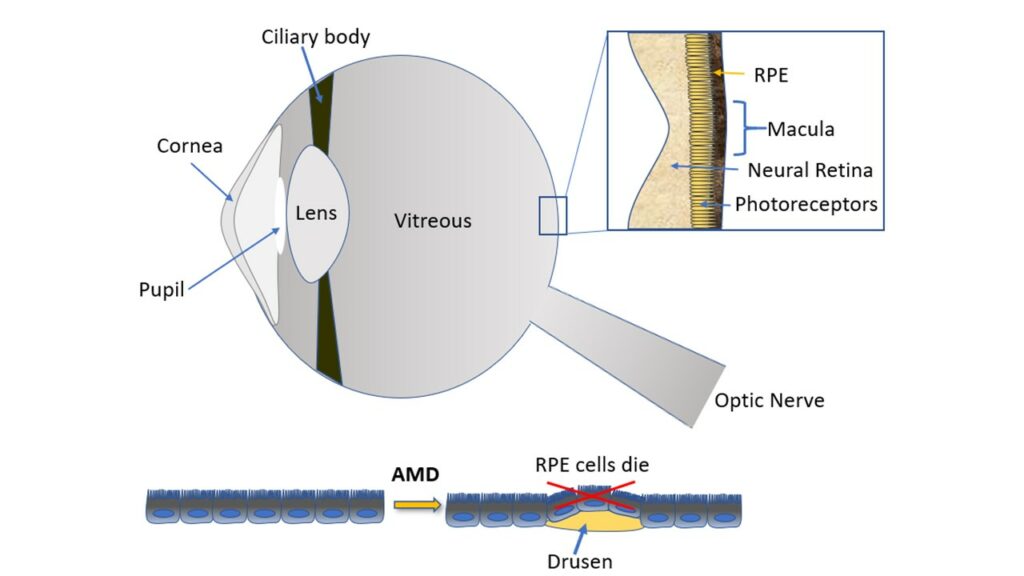Retinal Disease: Age-Related Macular Degeneration
Age-related Macular Degeneration (AMD) is the leading cause of vision loss in the USA, affecting 1 in 5 people over age 75. This condition begins when abnormal deposits called ‘drusen’ build up under the retinal pigment epithelium (RPE), a cell layer in the retina that is important for normal vision. Drusen are most noticeable in the macular region of the retina, which is responsible for high acuity and color vision. The RPE cells become dysfunctional and die, which weakens the overlying retina and impairs vision. Patients with AMD may lose the ability to read, recognize faces, watch TV, or do many tasks important for independent living.
Cell Replacement Therapy
New RPE cells can be made from stem cells and then injected under the retina to replace damaged RPE cells. This stem cell-based replacement therapy restores vision in animal models of AMD.
At NSCI we have discovered a unique adult human RPE stem cell (RPESC) that is present in the eye. With funding from the NYS stem cell program NYSTEM and from the National Eye Institute (NEI) we have advanced this cell to a successful IND application to the FDA in June 2020. Our planned Phase I/IIa clinical trial began in 2022 supported by LUXA Biotech. This trial will test RPESC-derived RPE cells to see if they are safe as a cell replacement therapy for AMD.
Stem Cells for Drug Discovery
Stem cells can be used to make human RPE cells in the research lab, enabling us to study the disease ‘in the dish’ to understand its causes and how to prevent it from starting or slow its progression. Healthy RPE cells can be stressed to produce abnormal cells that display features of AMD or other pathological conditions such as epiretinal membrane formation. Recreating key characteristics of retinal disease in cells in the culture dish greatly accelerates screening for drugs.
Further Reading
- Davis R.J., Alam N.M., Zhao C., Müller C., Saini J.S., Blenkinsop T.A., Mazzoni F, Campbell M., Borden S.M., Charniga C.J., Lederman P.L., Aguilar V., Naimark M., Fiske M., Boles N., Temple S., Finnemann S.C., Prusky G.T., Stern J.H. The Developmental Stage of Adult Human Stem Cell-Derived Retinal Pigment Epithelium Cells Influences Transplant Efficacy for Vision Rescue. Stem Cell Reports. 2017 Jul 11;9(1):42-49. PubMed PMID: 28625537; PubMed Central PMCID: PMC5511099.
- Davis R.J., Blenkinsop T.A., Campbell M., Borden S.M., Charniga C J., Lederman P.L., Frye A.M., Aguilar V., Zhao C., Naimark M., Kiehl T.R., Temple S., Stern J.H. Human RPE Stem Cell-Derived RPE Preserves Photoreceptors in the Royal College of Surgeons Rat: Method for Quantifying the Area of Photoreceptor Sparing. J Ocul Pharmacol Ther. 2016 Jun;32(5):304-9. PubMed PMID: 27182605.
Further Reading
- Boles NC, Fernandes M, Swigut T, Srinivasan R, Schiff L, Rada-Iglesias A, Wang Q, Saini JS, Kiehl T, Stern JH, Wysocka J, Blenkinsop TA, Temple S. Epigenomic and Transcriptomic Changes During Human RPE EMT in a Stem Cell Model of Epiretinal Membrane Pathogenesis and Prevention by Nicotinamide. Stem Cell Reports. 2020 Apr 14;14(4):631-647. PMID: 32243845
- Saini JS, Corneo B, Miller JD, Kiehl TR, Wang Q, Boles NC, Blenkinsop TA, Stern JH, Temple S. Nicotinamide Ameliorates Disease Phenotypes in a Human iPSC Model of Age-Related Macular Degeneration. Cell Stem Cell. 2017 May 4;20(5):635-647.e7. doi: 10.1016/j.stem.2016.12.015. PMID: 28132833

